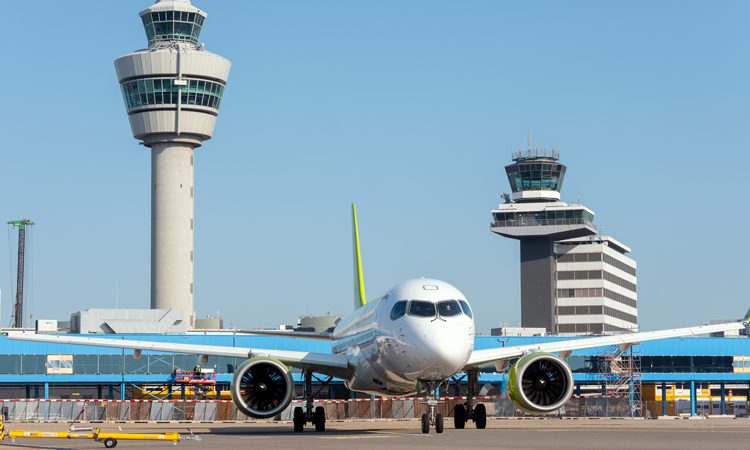Leveraging cargo operations at Amsterdam Airport Schiphol
- Like
- Digg
- Del
- Tumblr
- VKontakte
- Buffer
- Love This
- Odnoklassniki
- Meneame
- Blogger
- Amazon
- Yahoo Mail
- Gmail
- AOL
- Newsvine
- HackerNews
- Evernote
- MySpace
- Mail.ru
- Viadeo
- Line
- Comments
- Yummly
- SMS
- Viber
- Telegram
- Subscribe
- Skype
- Facebook Messenger
- Kakao
- LiveJournal
- Yammer
- Edgar
- Fintel
- Mix
- Instapaper
- Copy Link
Posted: 5 January 2023 | Lily Mae Pacey (International Airport Review) | No comments yet
Anne Marie van Hemert, Head of Aviation Business Development, Amsterdam Schiphol Airport spoke with International Airport Review’s Editorial Assistant, Lily Mae Pacey during Routes Europe 2022 in Bergen. Together they discussed the dominant role cargo operations played during and post-pandemic recovery, as well as how sustainability and digitalisation combined will shape Schiphol’s future.


Credit: Schiphol AMS
A change in passenger dynamics
Luckily, no matter how anxious a passenger may be to fly, there is always a large majority who are willing and ‘itching’ to travel again, whether that be for leisure or visiting friends or relatives (VFR). In a passenger survey at the beginning of 2022, 36 per cent of passengers travelling to, from, and through Schiphol were for holiday and leisure, 35 per cent were VFR, and business travellers made up 26 per cent of the results. “In the past and especially pre‑COVID-19, the figure for business passengers was higher, sitting at 32 per cent,” explained van Hemert.
An airport is like a city concept. We have a variety of food and beverage and retail, either for the ‘typical’ Dutch traveller, who are looking for the right value in quality and price, as well as fashion, liquor, and perfume stores for our Asian traveller type, who is wanting high yield products, displayed in a high‑quality design”
In 2019, Schiphol saw 71.7 million passengers pass through the airport. However, back in 2021, this dropped significantly to 25.5 million passengers, due to the impact of the pandemic. Over the first half of 2022, Schiphol welcomed back 27.3 million passengers.
“We trust in the fact that traffic is going to continue in high volumes and that we see a steady growth coming back.” During the summer season we did encounter various challenges to meet the increasing volume of passengers. “This was clearly reflected in the lack of security staff at the airport which led to longer waiting times than was standard pre‑COVID. On certain moments we were not delivering the product our passengers and airlines expected”. To be able to meet the demand, Schiphol had to limit the number of local departing passengers.
With a rise in leisure and VFR passengers at Schiphol, the airport has considered the different attributes, cultures, and expectations of this type of passenger.
“An airport is like a city concept. We have a variety of food and beverage and retail, either for the ‘typical’ Dutch traveller, who are looking for the right value in quality and price, as well as fashion, liquor, and perfume stores for our Asian traveller type, who is wanting high yield products, displayed in a high-quality design.”
Cargo: A new dot on the horizon
Like so many other airports across the globe, Schiphol experienced a boom in cargo operations during the COVID-19 pandemic. Now, looking to the future of cargo at the airport, operations will begin to look more like a ‘brand.’ The updated cargo strategy has been formulated in collaboration with the surrounding community, which looks at four different pillars: connectivity, seamless operations, sustainability, and safe and secure cargo operations.
The airport has developed a ‘pre‑notification’ for cargo and as part of the operations process, details and data are shared with Schiphol. Therefore, cargo can be more predictable and the operations more efficient and safer for all.
Schiphol’s ‘Smart Cargo Mainport’ programme focuses on these key pillars, supported by state-of-the-art digitisation and technology.
“I think it’s safe to say that this programme has brought the whole community closer together, as well as leveraged our action plans – we needed to have that speed again,” van Hemert added.
‘Connecting your world’ strategy
Schiphol’s future strategy, “is a large statement in itself,” which focuses on sustainability efforts, as well as, continuing high-quality services across the large network, which contains European destinations and intercontinental. The strategy capitalises on the idea of leveraging the airport’s new connections, but also securing existing route options to ensure they are future‑proof.
Although Amsterdam has been experiencing slot constraints, making it difficult to grow and develop routes, it is industry events, such as Routes Europe 2022, that opens the door between airlines, airports, and other partners to connect, build relationships and provide passengers with even greater choice of destinations. After Routes Europe 2022, the Dutch Government announced plan to cap the total capacity of the airport from the current 500,000 to 440,000 per November 2023. At this moment it is not known how this will be implemented.
Why should an airline choose Schiphol over other competitors?
Amsterdam Airport Schiphol has an excellent team of airline & cargo partnerships managers and within the team, personal attention is paid to airlines, cargo partners, and other stakeholders. The airport also has a healthy combination of passenger and cargo operations, allowing Schiphol to pay close attention to both types of transport.
On a larger scale, the airport has a ‘one terminal concept’, which allows easier travel for passengers, as well as the airport’s extensive network. Furthermore, Schiphol’s five-runway system allows the airport to operate despite sometimes difficult weather conditions, particularly ‘windy challenges.’
When asked, ‘What makes Schiphol so unique and gives passengers that sense of place?’ van Hemert initially commented on how the airport impacts her own personal passenger journey when travelling through Schiphol.
One roof concept
“We like to work on the idea that Schiphol is. a small airport in a small country, but we have major ambitions,” commented van Hemert.
The airport’s key goal is to meet the needs and requirements for every individual passenger, airline, and stakeholder, so that they feel at ease when at the airport and whilst in Amsterdam.
Sustainability is on the agenda
“Correct, it is on the agenda, but not just for us (airports). I think it should be globally, otherwise our children of the future will be living in a completely different environment.”
Across Schiphol, the airport has at least five key initiatives to help deter climate change:
- The airport has been operating on 100 per cent Dutch wind power since 2018
- Cooling and heating or thermal energy is used throughout the terminal
- 750 electrical vehicles for airside operations
- Schiphol works closely with recycling actions
- And, lastly, airport charges to account for the abatement of CO2 emissions.
In accordance with the airport’s target of zero CO2 emissions by 2030, sustainability has been incorporated into Schiphol’s cargo and passenger airline strategy. Schiphol is striving for sustainability both from an airport’s side, as well as in alliance with its surrounding communities and clients.
Furthermore, a key driver for Schiphol’s ambitious sustainability plans is through using Taxibots. Taxibots not only encourage airlines to be more sustainably active but, also, to choose Schiphol as a route destination. With the airport’s five runways, the Taxibots support the process of shuttling aircrafts to the beginning of the runway, without using its own fuel and emissions.
We like to work on the idea that Schiphol is. a small airport in a small country, but we have major ambitions”
A key and crucial development that has been a result of the COVID-19 pandemic, was a look at how internally the company is organised. “I say, never waste a good crisis! And, in this case we came up with a new way of working within Schiphol,” said van Hemert.
Schiphol has now formed new departments, but also combined different developing departments to gather ideas as a collective, with more execution power and immediate action. From the airlines – stakeholders – the clients, working operationally more efficiently and effectively.
Schiphol’s future
The airport is working in an ambitious playing field to overcome challenges and surpass passenger and client expectations. “We are still focused on developing our firm network. However, our focus is to expand, secure existing connections, but most of all, deliver.”
Biography


Related topics
Air freight and cargo, Air traffic control/management (ATC/ATM), Airside operations, COVID-19, Digital transformation, Emissions, Passenger experience and seamless travel, Route development, Sustainability, Sustainable development, Terminal operations


















